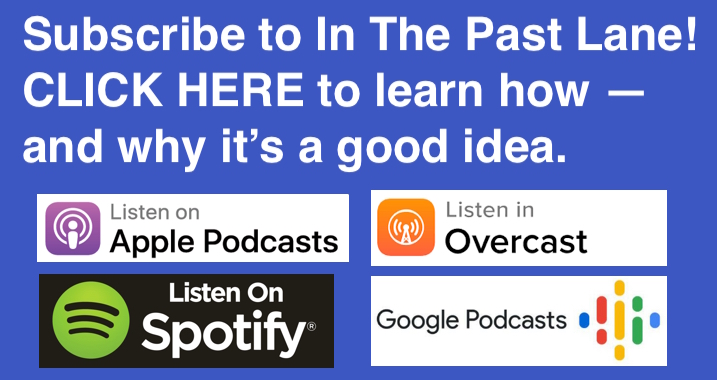 This week at In The Past Lane, the American History podcast, we learn about the February 20, 1939 Nazi rally at Madison Square Garden in New York City. It was organized by a pro-Nazi, pro-fascist organization called the German American Bund and it drew a capacity crowd of 20,000. The event fused professions of American patriotism with vile antisemitism and pro-Nazi sentiment. But the Bund’s rally did not go unchallenged. As many as 100,000 anti-Nazis filled the streets around MSG to register their outrage. The negative publicity caused the Bund to lose members. Then six months later World War II started and the Bund was on its way into the dustbin of history.
This week at In The Past Lane, the American History podcast, we learn about the February 20, 1939 Nazi rally at Madison Square Garden in New York City. It was organized by a pro-Nazi, pro-fascist organization called the German American Bund and it drew a capacity crowd of 20,000. The event fused professions of American patriotism with vile antisemitism and pro-Nazi sentiment. But the Bund’s rally did not go unchallenged. As many as 100,000 anti-Nazis filled the streets around MSG to register their outrage. The negative publicity caused the Bund to lose members. Then six months later World War II started and the Bund was on its way into the dustbin of history.
And we also take a look at some key events that occurred this week in US history, like John Glenn’s history making orbit of the earth, the assassination of Malcolm X, and the publication of The Feminine Mystique. And birthdays, including
February 17, 1942: Huey Newton
February 21, 1936: Congressman Barbara Jordan
February 22, 1732: George Washington
Feature story:
On February 20, 1939 – 81 years ago this week – 20,000 people gathered in New York City‘s Madison Square Garden for what was billed as a “Pro American Rally.“ Upon entering the stadium, attendees saw a 30-foot tall banner featuring the image of George Washington. Red, white, and blue American flags were everywhere and the festivities began with a rousing rendition of the “Star Spangled Banner.”
But this was no ordinary political gathering. Indeed, interspersed among all the symbols of American patriotism were swastikas, Nazi uniforms, and banners that read: Stop Jewish Domination of Christian Americans. It was 1939, six months before the start of World War II, and 20,000 American Nazis had come together to praise Hitler, pledge loyalty to America, and denounce Jews as a threat to white Christian America. It was one of the most flagrant and vile displays of anti-Semitism in U.S. history.
The group behind the rally was the German American Bund – bund being the German word for federation. This German American organization had been founded in 1936 by a man named Fritz Kuhn. It wrapped its pro-fascist, pro-Nazi, anti-Semitism in the mantle of American patriotism. They presented themselves as defenders of America from subversive communists and Jews who were plotting to undermine American values and Christianity. The Bund held summer camps for families, published pamphlets and magazines, and held high profile public events like parades and rallies. Within a few years, the organization boasted tens of thousands of members, and countless more supporters and sympathizers.
 But in 1939, as American opposition to Hitler and the Nazi regime grew, Bund membership began to decline. So, in an effort to boost its fortunes, the German American Bund booked a rally in the nation’s premier venue: Madison Square Garden. The Bund’s founder, Fritz Kuhn, knew the event would spark outrage and protest. But he didn’t care. Controversy was just what he wanted. It was free advertising and, he thought, it would surely bring more Americans to support Nazism and fascism.
But in 1939, as American opposition to Hitler and the Nazi regime grew, Bund membership began to decline. So, in an effort to boost its fortunes, the German American Bund booked a rally in the nation’s premier venue: Madison Square Garden. The Bund’s founder, Fritz Kuhn, knew the event would spark outrage and protest. But he didn’t care. Controversy was just what he wanted. It was free advertising and, he thought, it would surely bring more Americans to support Nazism and fascism.
New York City officials were less than thrilled about the event. Nonetheless, they rebuffed calls to stop the rally. Mayor Fiorello LaGuardia reasoned that the negative publicity from the event would actually hurt the Bund’s popularity.
So instead of cancelling the event, the city put 1500 policeman in and around Madison Square Garden on the night of the rally. The heavy police presence proved a wise move, as tens of thousands of anti-Nazi protesters showed up, many looking for a fight.
Inside Madison Square Garden, the rally went off perfectly – just as Fritz Kuhn had planned. There was music and speeches, interspersed by frenzied cheering, emphatic Nazi salutes, and shouts of Heil Hitler! The grand finale was a speech by Fritz Kuhn himself. He denounced Jews and communists as menaces to America. He likewise denounced President Franklin Delano Roosevelt, referring to him repeatedly as “Franklin Rosenfeld,” and his popular New Deal programs as the “Jew Deal.” Roosevelt, of course, wasn’t Jewish, but fascists like Kuhn saw him as an agent of Jewish-inspired socialism. “We, with American ideals,” shouted Kuehne, “demand that our government shall be returned to the American people who founded it” – implying, of course, that Jews were in control of the country and that they were not then, and never could be, true Americans. He continued, “If you ask what we are actively fighting for under our charter: First, a socially just, white, Gentile-ruled United States. Second, Gentile-controlled labor unions, free from Jewish Moscow-directed domination.” The crowd roared in approval and thousands of arms shot fourth in the Nazi salute.
But then, something extraordinary occurred. A Jewish American man named Isador Greenbaum jumped on stage to denounce Kuhn and his hateful movement. Policemen and Bund guards pounced on Greenbaum and pummeled him with their fists before dragging him off stage. Greenbaum’s newly suicidal act of protest didn’t stop the rally. But it stands out as an incredibly courageous and selfless act in defense of America’s ideals of democracy, tolerance, and inclusion. For his troubles, Greenbaum was arrested and fined $25 for disorderly conduct. Several dozen more protesters outside were also arrested for scuffling with police and Nazis.
The Bund’s membership declined rapidly as the American public became more and more aware of the evil actions of the Nazi regime and as a full-blown anti-Nazi movement took hold in the US. Fritz Kuhn was soon arrested for embezzlement of Bund funds and sent to prison. During World War II, he was stripped of his US citizenship, and following the war, deported to Germany.
To most 21st-century Americans, this story of American Nazis is alarming and hard to believe. Photographs of Bund events are especially shocking. I’ll post a link in the show notes to a photo essay that appeared in The Atlantic that shows thousands of Americans in suburban New York and New Jersey giving the Nazi salute as a German American Bond parade goes by.
This story of the 1939 Madison Square Garden rally and these photos reveal a dark truth about American history: that forms of fascism, authoritarianism, white supremacy, and anti-Semitism have long attracted large followings, even if they’ve remained out of sight. We all became aware of that in 2017 when thousands of neo-Nazis marched in Charlottesville, Virginia.
But this story also reveals a brighter side of American history: that brave Americans – like Isador Greenbaum and the thousands of anti-Nazi protesters who showed up outside Madison Square Garden – have always stood up in the face of injustice.
If you want to know more about the 1939 Nazi rally at Madison Square Garden, I highly recommend an episode by the magnificent podcast, The Memory Palace. It’s titled, Episode 109: The Year Hank Greenberg Hit 58 Home Runs.
I also recommend the 2017 documentary about the rally titled “A Night at the Garden.” I’ll put links in the show notes to both these things.
Links:
The Memory Palace – Episode 109: The Year Hank Greenberg Hit 58 Home Runs
“A Night at the Garden” https://anightatthegarden.com/
“American Nazis in the 1930s—The German American Bund,” The Atlantic, June 5, 2017
For more information about the In The Past Lane podcast, head to our website, www.InThePastLane.com
Music for This Episode
Jay Graham, ITPL Intro (JayGMusic.com)
The Joy Drops, “Track 23,” Not Drunk (Free Music Archive)
Borrtex, “Perception” (Free Music Archive)
Blue Dot Sessions, “Pat Dog” (Free Music Archive)
Jon Luc Hefferman, “Winter Trek” (Free Music Archive)
The Bell, “I Am History” (Free Music Archive)
Production Credits
Executive Producer: Lulu Spencer
Graphic Designer: Maggie Cellucci
Website by: ERI Design
Legal services: Tippecanoe and Tyler Too
Social Media management: The Pony Express
Risk Assessment: Little Big Horn Associates
Growth strategies: 54 40 or Fight
© In The Past Lane, 2020
Recommended History Podcasts
Ben Franklin’s World with Liz Covart @LizCovart
The Age of Jackson Podcast @AgeofJacksonPod
Backstory podcast – the history behind today’s headlines @BackstoryRadio
Past Present podcast with Nicole Hemmer, Neil J. Young, and Natalia Petrzela @PastPresentPod
99 Percent Invisible with Roman Mars @99piorg
Slow Burn podcast about Watergate with @leoncrawl
The Memory Palace – with Nate DiMeo, story teller extraordinaire @thememorypalace
The Conspirators – creepy true crime stories from the American past @Conspiratorcast
The History Chicks podcast @Thehistorychix
My History Can Beat Up Your Politics @myhist
Professor Buzzkill podcast – Prof B takes on myths about the past @buzzkillprof
Footnoting History podcast @HistoryFootnote
The History Author Show podcast @HistoryDean
More Perfect podcast – the history of key US Supreme Court cases @Radiolab
Revisionist History with Malcolm Gladwell @Gladwell
Radio Diaries with Joe Richman @RadioDiaries
DIG history podcast @dig_history
The Story Behind – the hidden histories of everyday things @StoryBehindPod
Studio 360 with Kurt Andersen – specifically its American Icons series @Studio360show
Uncivil podcast – fascinating takes on the legacy of the Civil War in contemporary US @uncivilshow
Stuff You Missed in History Class @MissedinHistory
The Whiskey Rebellion – two historians discuss topics from today’s news @WhiskeyRebelPod
American History Tellers @ahtellers
The Way of Improvement Leads Home with historian John Fea @JohnFea1
The Bowery Boys podcast – all things NYC history @BoweryBoys
Ridiculous History @RidiculousHSW
The Rogue Historian podcast with historian @MKeithHarris
The Road To Now podcast @Road_To_Now
Retropod with @mikerosenwald
